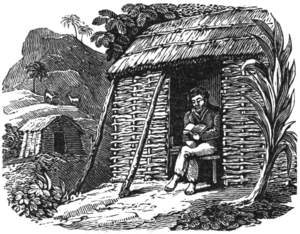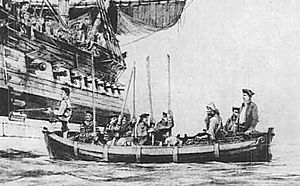Alexander Selkirk facts for kids
Quick facts for kids
Alexander Selkirk
|
|
|---|---|
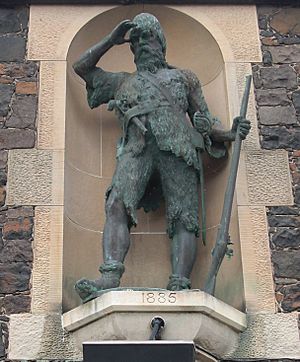
Clad in goatskins, Selkirk awaits rescue in a sculpture by Thomas Stuart Burnett (1885)
|
|
| Born | 1676 Lower Largo, Fife, Scotland
|
| Died | 13 December 1721 (aged 45) Cape Coast, Gold Coast
|
| Nationality | Scottish and British (after 1707) |
| Occupation | Sailor |
| Known for | Inspiring Robinson Crusoe |
| Parent(s) | John Selcraig, Euphan Mackie |
Alexander Selkirk (1676–13 December 1721) was a Scottish privateer and Royal Navy officer. A privateer was like a sailor who had permission from their government to attack enemy ships during wartime. Selkirk became famous for spending four years and four months all alone on an uninhabited island in the South Pacific Ocean. He was left there by his captain from 1704 to 1709.
Selkirk had a difficult personality when he was young. He joined sea voyages to the South Pacific during a big war called the War of the Spanish Succession. On one trip, he was on a ship called Cinque Ports. Its captain was Thomas Stradling, and the whole group was led by William Dampier.
The ship stopped at the Juan Fernández Islands, which are west of South America, to get supplies. Selkirk believed the ship was not safe to sail and asked to be left on the island. His worries were right, because Cinque Ports later sank near Malpelo Island.
After a long time, Selkirk was finally rescued by an English privateer named Woodes Rogers, who was with Dampier. By then, Selkirk had become very good at hunting and using the island's resources. His amazing survival story became very popular when he returned to England. It even helped inspire the famous writer Daniel Defoe to create the character Robinson Crusoe.
Contents
Early Life and Sea Adventures
Alexander Selkirk was born in 1676 in Lower Largo, Fife, Scotland. His father was a shoemaker. When he was young, Alexander was known for his difficult behavior. He often got into trouble.
In 1703, he joined an expedition led by the English privateer and explorer William Dampier. They sailed from Ireland on September 11. They had special permission to attack enemy ships because England was at war with Spain. Dampier was the captain of one ship, St George, and Selkirk served on Cinque Ports as a sailing master. This means he was an experienced sailor.
In February 1704, after a rough journey around Cape Horn, the privateers fought a French ship. Later, they tried to raid a gold mining town but were ambushed. They did capture a ship full of goods, but Dampier decided to let it go, which disappointed many of the men. In May 1704, Captain Stradling of Cinque Ports decided to leave Dampier's group and sail on his own.
Becoming a Castaway
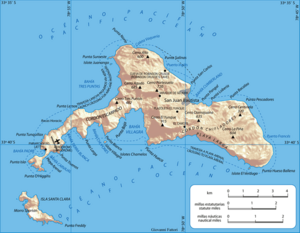
In September 1704, Captain Stradling brought Cinque Ports to an island called Más a Tierra. This island is part of the uninhabited Juan Fernández Islands, about 670 km (416 mi) off the coast of Chile. They stopped there to get fresh water and supplies.
Selkirk was very worried about how safe their ship was. He wanted to fix it before they went any further. He even said he would rather stay on the island than continue on a leaky ship. Captain Stradling took him seriously and left Selkirk on the island.
Selkirk was given a musket (a type of gun), a hatchet, a knife, a cooking pot, a Bible, bedding, and some clothes. He immediately regretted his quick decision, but Stradling would not let him back on board.
Selkirk's fears about the ship were proven right. Cinque Ports later sank off the coast of what is now Colombia. Captain Stradling and some of his crew survived. However, they were captured by the Spanish and held in a harsh prison in Lima, Peru.
Life Alone on the Island
At first, Selkirk stayed near the beach of Más a Tierra. He ate spiny lobsters and looked out at the ocean every day, hoping for rescue. He felt very lonely and sad. Large groups of noisy sea lions gathered on the beach for mating season, which eventually made him move further inland.
Once he moved away from the shore, his life got better. He found more food. Wild feral goats, brought by earlier sailors, gave him meat and milk. He also ate wild turnips, leaves from cabbage trees, and dried Schinus fruits, which are like pink peppercorns. Rats would bother him at night, but he solved this by taming some feral cats and living near them. This helped him sleep safely.
Selkirk was very clever at using what he found on the island. He made a new knife from metal barrel hoops left on the beach. He built two huts from pepper trees; one for cooking and one for sleeping. He used his musket to hunt goats and his knife to prepare them. As his gunpowder ran out, he had to chase goats on foot. During one chase, he fell from a cliff and was badly hurt. He lay helpless for about a day. Luckily, the goat he was chasing cushioned his fall, probably saving him from breaking his back.
Lessons from his father, who was a tanner (someone who prepares animal skins), helped him greatly. When his clothes wore out, he made new ones from goatskins using a nail for sewing. His shoes eventually fell apart, but he didn't need new ones because his feet became tough and calloused. He sang psalms and read from his Bible, which comforted him and helped him keep his English sharp.
During his time on the island, two Spanish ships anchored there. As a Scottish privateer, Selkirk knew he would be in big trouble if captured. So, he did his best to hide. Once, a group of Spanish sailors spotted him and chased him. He hid in a tree, and they didn't notice him. They eventually gave up and sailed away.
His Rescue
Selkirk's rescue finally came on February 2, 1709. Two privateering ships, Duke and Duchess, arrived. William Dampier was the pilot for Duke. Thomas Dover led the group that met Selkirk. After four years and four months without seeing another human, Selkirk was overjoyed and almost couldn't speak clearly.
The captain of Duke, Woodes Rogers, jokingly called Selkirk the "governor of the island." Selkirk was very agile and caught two or three goats a day. He helped Rogers' men, who were sick with scurvy, get healthy again.
Captain Rogers was impressed by Selkirk's strength and his calm mind. He noted that living alone wasn't as bad as most people think, especially when someone is forced into it. Rogers made Selkirk the second mate on Duke. Later, Selkirk was given command of one of the captured enemy ships, Increase.
Selkirk returned to privateering with great energy. He helped capture a valuable Spanish ship, Nuestra Señora de la Encarnación y Desengaño. He served as sailing master on this ship, which was renamed Bachelor. Selkirk completed a trip around the world, arriving back in England on October 1, 1711. He had been away for eight years.
Later Life and Influence

Selkirk's story as a castaway became very famous in England. Other sailors who were with him wrote about his experiences. The leader of the expedition, Woodes Rogers, also published a detailed account. A famous writer named Richard Steele wrote an article about Selkirk in a newspaper.
Selkirk seemed set for an easy life, as he was due to receive a lot of money from the captured wealth. However, legal problems made it hard to get his full share.
After a few months in London, he started to act like his old self again. But he still missed his quiet time alone. He once said, "I am now worth eight hundred pounds, but shall never be as happy as when I was not worth a farthing" (a very small coin).
He returned to Lower Largo and later joined the Royal Navy. He died on December 13, 1721, from yellow fever while serving on a ship called HMS Weymouth off the coast of West Africa. He was buried at sea.
When Daniel Defoe published his famous book The Life and Surprising Adventures of Robinson Crusoe in 1719, many readers noticed how similar the story was to Selkirk's. The first picture in the book shows a sad-looking man on an island, dressed in goatskins, just like Selkirk. This shows that Selkirk's story was a big inspiration for the character of Robinson Crusoe.
In Other Stories and Art
- The poem "The Solitude of Alexander Selkirk" by William Cowper is about Selkirk's feelings of being alone on the island. It includes the famous line: "I am monarch of all I survey."
- Jorge Luis Borges wrote a poem about Selkirk. In it, Selkirk dreams of the island and wishes he could comfort his past self.
- Charles Dickens mentioned Selkirk in his book The Pickwick Papers, using him as an example of someone who is "Monarch of all they surveyed."
- Poet Patrick Kavanagh compared his own loneliness to Selkirk's in his poem "Inniskeen Road: July Evening."
- In one of W. S. Gilbert's Bab Ballads, Selkirk is used as a model for castaways.
- Joshua Slocum mentions Selkirk in his book Sailing Alone Around the World after visiting the Juan Fernández Islands.
In Film
Selkirk, the Real Robinson Crusoe is a stop motion animated film based on Selkirk's life. It was released in 2012 and was the first full-length animated movie made in Uruguay.
Remembering Selkirk
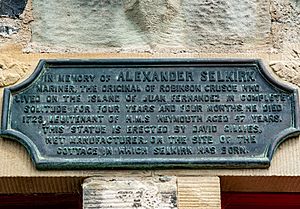
Selkirk is remembered in his hometown in Scotland. In 1885, a bronze statue and plaque were put up in his memory in Lower Largo. The statue was created by Thomas Stuart Burnett.
He is also remembered on the island where he lived. In 1869, sailors from a ship placed a bronze tablet at a place called Selkirk's Lookout on a mountain on Más a Tierra. On January 1, 1966, the Chilean president renamed Más a Tierra to Robinson Crusoe Island to attract tourists. The largest of the Juan Fernández Islands, formerly called Más Afuera, was renamed Alejandro Selkirk Island, even though Selkirk probably never visited that island.
Archaeological Discoveries
In February 2005, an archaeological team on the Juan Fernández Islands found a piece of a nautical tool. It was a "fragment of copper alloy identified as being from a pair of navigational dividers" from the early 1700s. Selkirk is the only person known to have been on the island at that time who would likely have had such tools. This artifact was found near Selkirk's Lookout, where he is thought to have lived.
In 1825, during research for Selkirk's biography, his "flip-can" (a type of drinking vessel) was owned by his great-grand-nephew. Selkirk's musket was also in the possession of Major Lumsden.
See Also
 In Spanish: Alexander Selkirk para niños
In Spanish: Alexander Selkirk para niños
- List of people who disappeared mysteriously at sea


